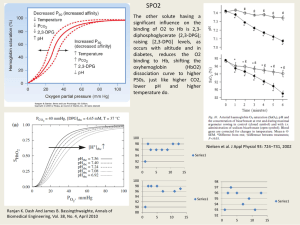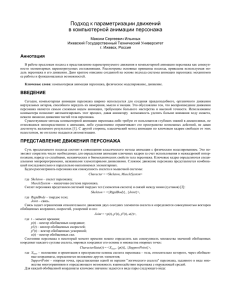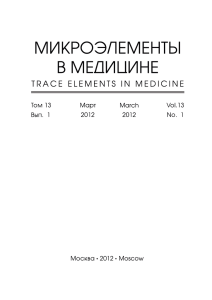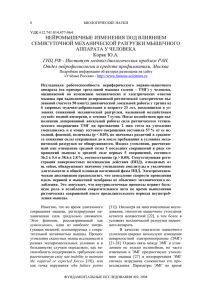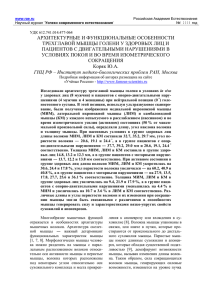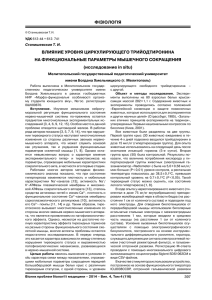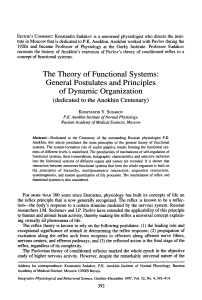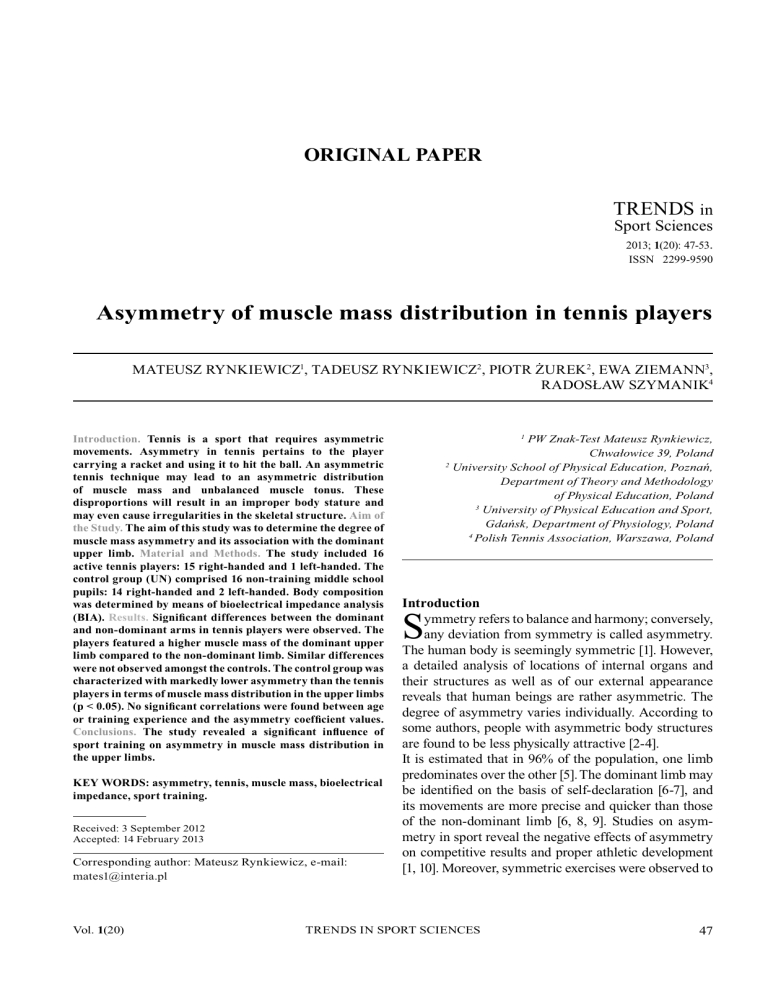
ASYMMETRY OF MUSCLE MASS DISTRIBUTION IN TENNIS PLAYERS ORIGINAL PAPER TRENDS in Sport Sciences 2013; 1(20): 47-53. ISSN 2299-9590 Asymmetry of muscle mass distribution in tennis players MATEUSZ RYNKIEWICZ1, TADEUSZ RYNKIEWICZ2, PIOTR ŻUREK 2, EWA ZIEMANN3, RADOSŁAW SZYMANIK4 Introduction. Tennis is a sport that requires asymmetric movements. Asymmetry in tennis pertains to the player carrying a racket and using it to hit the ball. An asymmetric tennis technique may lead to an asymmetric distribution of muscle mass and unbalanced muscle tonus. These disproportions will result in an improper body stature and may even cause irregularities in the skeletal structure. Aim of the Study. The aim of this study was to determine the degree of muscle mass asymmetry and its association with the dominant upper limb. Material and Methods. The study included 16 active tennis players: 15 right-handed and 1 left-handed. The control group (UN) comprised 16 non-training middle school pupils: 14 right-handed and 2 left-handed. Body composition was determined by means of bioelectrical impedance analysis (BIA). Results. Significant differences between the dominant and non-dominant arms in tennis players were observed. The players featured a higher muscle mass of the dominant upper limb compared to the non-dominant limb. Similar differences were not observed amongst the controls. The control group was characterized with markedly lower asymmetry than the tennis players in terms of muscle mass distribution in the upper limbs (p < 0.05). No significant correlations were found between age or training experience and the asymmetry coefficient values. Conclusions. The study revealed a significant influence of sport training on asymmetry in muscle mass distribution in the upper limbs. KEY WORDS: asymmetry, tennis, muscle mass, bioelectrical impedance, sport training. Received: 3 September 2012 Accepted: 14 February 2013 Corresponding author: Mateusz Rynkiewicz, e-mail: [email protected] Vol. 1(20) 1 PW Znak-Test Mateusz Rynkiewicz, Chwałowice 39, Poland 2 University School of Physical Education, Poznań, Department of Theory and Methodology of Physical Education, Poland 3 University of Physical Education and Sport, Gdańsk, Department of Physiology, Poland 4 Polish Tennis Association, Warszawa, Poland Introduction ymmetry refers to balance and harmony; conversely, any deviation from symmetry is called asymmetry. The human body is seemingly symmetric [1]. However, a detailed analysis of locations of internal organs and their structures as well as of our external appearance reveals that human beings are rather asymmetric. The degree of asymmetry varies individually. According to some authors, people with asymmetric body structures are found to be less physically attractive [2-4]. It is estimated that in 96% of the population, one limb predominates over the other [5]. The dominant limb may be identified on the basis of self-declaration [6-7], and its movements are more precise and quicker than those of the non-dominant limb [6, 8, 9]. Studies on asymmetry in sport reveal the negative effects of asymmetry on competitive results and proper athletic development [1, 10]. Moreover, symmetric exercises were observed to S TRENDS IN SPORT SCIENCES 47 RYNKIEWICZ, RYNKIEWICZ, ŻUREK, ZIEMANN, SZYMANIK have a positive influence on the technical skills of athletes practicing asymmetric sports [1, 11]. Tennis is a sport that requires asymmetric movements. Asymmetry in tennis pertains to the player carrying a racket and using it to hit the ball. However, most tennis player’s movements across the court are symmetric. Symmetry is particularly important in players who frequently hit the tennis ball with high power. An asymmetric technique may lead to an asymmetric distribution of muscle mass and unbalanced muscle tonus [12-14]. These disproportions will result in an improper body stature and may even cause irregularities in the skeletal structure [14]. These consequences are particularly harmful since they may lead to injuries and joint overloading, and with time they may also result in degenerative changes [15, 16]. This may be particularly dangerous for young individuals, especially those at the stage of intensive skeletal and muscular development. Previous studies on tennis players dealt with their fat tissue levels and determination of other physiological parameters [17-19]. The effects of participating in recreational tennis and bone mineral density of the arms were assessed in postmenopausal women [14]. Finally, an increase in the asymmetry of static power of upper limbs was observed in young tennis players in a yearly training cycle [20]. Structural differences between dominant and non-dominant upper limbs were found in athletes [21, 22]. Also research on arm volume revealed this parameter is characterized by a higher level of asymmetry in young tennis players than in their non-training peers [23]. Balius et al. observed differences in the structure and mass of rectus abdominis muscle between the dominant and non-dominant sides of body of tennis players [24]. Moreover, tennis players were characterized by markedly higher levels of muscle mass asymmetry in their upper limbs, as compared with athletes practicing other sports or non-training individuals [25-28]. Furthermore, it was observed that the level of asymmetry in adult athletes was higher than in children [29, 30]. The asymmetry in muscle mass and bone density was proved to be modulated by the number of training hours [30]. It was revealed that the grip strength of the dominant hand in female and male tennis players was 25% and 18% higher as compared with the strength of non-dominant hand [22]. It is postulated that tennis players should spend more time on training aimed at decreasing the asymmetry level, thus indirectly reducing the risk of injury [31]. 48 Aim of Study There have been several studies dealing with the problem of structural asymmetry of the upper limbs in young and adult tennis players. These studies used a variety of methods of asymmetry determination, including ultrasonography [24], magnetic resonance imaging [25], dual-energy X-ray absorptiometry [26-30] and anthropometry [21-23]. Although methods such as magnetic resonance imaging constitute a “gold standard” in the structural examination of muscles and bones, they are extremely expensive and time consuming and cannot be utilized in field conditions. In contrast, anthropometry can be used in virtually all conditions, but requires the knowledge of proper formulas and precise measurement, as well as skilled examiners. The aim of this study was to apply bioelectric impedance analysis to determine the degree of muscle mass asymmetry and its association with the dominant upper limb. It was hypothesized that: 1) training of tennis players leads to increased asymmetry in the muscle mass of their upper limbs, and that the degree of these changes can be determined with the aid of segmental analysis of body composition; 2) tennis players exhibit a higher degree of asymmetry in muscle mass distribution when compared to non-training individuals; and 3) the degree of asymmetry in muscle mass distribution is related to players’ training experience and is indirectly associated with their age. Material and Methods The study sample included 16 practicing tennis players (T). The participants’ mean age was 15.19 ± 1.05 years, and the length of their training experience amounted to 8.94 ± 1.12 years. The athletes’ mean body height was 177.38 ± 8.14 cm, and their mean body mass was 67.66 ± 12.29 kg. All participants represented a high sport class. They were members of the Polish junior or cadet national teams. Fifteen participants played tennis with the right arm and one with the left arm. The control group (UN) comprised pupils from a middle school from Gorzów Wielkopolski, Poland. It included 16 boys aged 14.13 ± 0.34 years. Their mean body height and weight were 174.69 ± 4.81 cm and 70.43 ± 20.55 kg, respectively. Fourteen of the controls declared being right-handed, and two were left-handed. Body height was determined using standard measurement procedures. Body mass and composition, along with muscle mass distribution, were determined by TRENDS IN SPORT SCIENCES March 2013 ASYMMETRY OF MUSCLE MASS DISTRIBUTION IN TENNIS PLAYERS means of multi-frequency bioelectrical impedance measurements. The results of muscle mass of the right arm, left arm, right leg and left leg were used. These measurements were taken with the use of InBody (model 720) analyzer with eight electrodes. This type of analysis is characterized by high precision and reproducibility [32, 33]. Asymmetry coefficients of muscle mass distribution in the upper (AA) and lower limbs (AL) were calculated as follows [34, 35]: WAE = (xd – xnd)/((xd + xnd) / 2) · 100% Xd – muscle mass on the dominant side [kg]; Xnd – muscle mass on the non-dominant side [kg]. Statistical analysis was performed using the Statistica 8.0 software package (StatSoft Inc. 2009). The significance of differences between arithmetic means was verified using the Student’s t-test. The study protocol was approved by the Bioethical Commission of Adam Mickiewicz University in Poznań. Results The analysis of muscle mass distribution within various segments of the body revealed that the studied athletes were characterized by larger muscle mass of the dominant arm (Table 1). The asymmetry of upper limb muscle mass of tennis players corresponded to 4.06% and did not prove statistically significant. Similarly, no significant differences were found between the muscle mass of the dominant and non-dominant lower limbs, with the level of asymmetry of 0.41%. Furthermore, no significant differences with regard to muscle mass distribution between the dominant and non-dominant arms were revealed in the controls, with the asymmetry corresponding to only –0.02%. The level of muscle mass asymmetry was higher in lower limbs (2.69%). The differences between the dominant and non-dominant arms in the controls did not prove statistically significant, similar to the differences in muscle mass distribution between the dominant and non-dominant lower limb. Muscle mass in the upper and lower limbs was also compared between the tennis players and the control group. Significant differences were observed between these groups in terms of the dominant and non-dominant limb muscle mass (AA and AL) (Table 1). Vol. 1(20) The next stage of analysis included verifying the association between training experience (Fig. 1) or age (Fig. 2) and AA in the tennis players. No significant relationship was found in the correlation analysis. What this paper adds? Studies on tennis players have documented structural differences between the dominant and non-dominant upper limbs. A review of literature identified a number of studies dealing with the problem of the structural asymmetry of upper limbs in tennis players. Previously used methods are very accurate but they are extremely expensive and time consuming and cannot be utilized in field conditions. The aim of this study was to apply bioelectrical impedance analysis to determine the degree of muscle mass asymmetry and its association with the dominant upper limb. Segmental analysis of body composition with the aid of bioelectrical impedance enables a quick and easy determination of muscle mass asymmetry. Discussion Due to its specific playing technique, tennis is associated with a considerable load of the dominant arm; this is reflected by higher strength developed by this limb [20] as well as by structural asymmetry of the upper limbs [12-14, 21-25, 26-29, 36]. TRENDS IN SPORT SCIENCES 49 RYNKIEWICZ, RYNKIEWICZ, ŻUREK, ZIEMANN, SZYMANIK 50 TRENDS IN SPORT SCIENCES March 2013 ASYMMETRY OF MUSCLE MASS DISTRIBUTION IN TENNIS PLAYERS Although some differences with regard to the muscle mass of the dominant and non-dominant upper limbs were observed in Group T, none of them proved statistically significant. The lack of statistically significant differences was also noted in the controls. Additionally, we observed a significant difference in the level of upper limb asymmetry (AA) of participants from Groups T and UN. The findings of this study confirmed our initial hypothesis according to which tennis players’ training is reflected by the asymmetric development of muscle mass. This phenomenon should be considered unfavorable since it can be reflected by an array of degenerative changes and injuries [14-16, 24]. Tennis players are characterized by a higher degree of upper limb asymmetry as compared with athletes practicing other sports [28]. Moreover, a study of volleyball players showed that a high level of asymmetry between the right and the left side of the body can lead to scoliosis [37]. Sanchis-Moysi et al. (2010c) observed that the level of fat-free mass asymmetry in young players who practiced tennis five times or twice a week amounted to 13.3 ± 6.4% or 8.3 ± 4.8%, respectively. Although these values were lower as compared with professional tennis players [30], they were higher than those observed in our study. However, the abovementioned findings were obtained with dual-energy X-ray absorptiometry. Although this method is highly precise and reliable, it is expensive and difficult to apply. On the basis of our findings it can be concluded that the proposed method of bioelectrical impedance can be used to determine the level of muscle mass asymmetry in the lower limbs. Furthermore, it can be utilized for quick and easy control of traininginduced changes. It should be noted that asymmetry is a negative phenomenon from the viewpoint of training practice. Many studies confirmed a positive influence of symmetric training on the improvement of technical skills and motor coordination. According to Starosta [1], symmetric training is associated with a bilateral transfer of motor skills, enabling improvement of motor coordination and the technique of movement in both dominant and nondominant limb. Additionally, the phenomenon of active recovery can be utilized during alternate exercising of the dominant and non-dominant arm. Post-exercise recovery can be faster due to alternate induction and inhibition of neural impulses [1, 38]. Moreover, it was revealed that symmetric training enables compensation of predominant asymmetric exercises [1, 31]. Therefore, we postulate that symmetric exercises, in particular those Vol. 1(20) involving both upper limbs, should be implemented in young tennis players’ training, especially those at a phase of supervised training. Probably, the lack of significant relationships between the degree of asymmetry, age, and training experience resulted from the homogeneity of Group T with regard to the two latter parameters. Therefore, it is advisable to analyze the upper limb distribution of muscle mass in a larger and more heterogeneous group of athletes. This seems necessary in view of previously published reports on age-related increase in the degree of morphological asymmetry [38, 39] and differences between children and professional athletes with regard to the asymmetry level [30]. It would be interesting to conduct a longitudinal study analyzing the degree of changes resulting from athletes’ age and training experience. Such a study would be particularly interesting in children who are at the beginning of their sports training period, since according to [28], the structural changes of upper limbs can be observed already in young, prepubertal children. Conclusions 1. In young tennis players sport training results in increased muscle mass of the dominant upper limb and, consequently, in an asymmetry in muscle mass distribution. Segmental analysis of the body composition with the aid of bioelectrical impedance enables a quick and easy determination of muscle mass asymmetry. 2. Young athletes who practice tennis are characterized by higher muscle mass asymmetry than untrained controls. 3. The homogeneity of the study group in terms of age and training experience, along with high variability of muscle mass and low sample size, meant that we were unable to verify if professional experience or age influenced the degree of muscle mass asymmetry. References 1. Starosta W. Stronne zróżnicowanie techniki ćwiczeń zawodników rozmaitych dyscyplin sportu (Lateral variation of different training techniques of athletes of various sports). Warszawa–Supraśl. 2008. 2. Brown WM, Price ME, Kang J, et al. Fluctuating asymmetry and preferences for sex-typical bodily characteristics. Proc Natl Acad Sci USA. 2004; 105: 12938-12943. 3. Etcoff N. Przetrwają najpiękniejsi (The most beautiful will survive). Warszawa, WAB, 2000. TRENDS IN SPORT SCIENCES 51 RYNKIEWICZ, RYNKIEWICZ, ŻUREK, ZIEMANN, SZYMANIK 4. Kujawa B, Strzałko J. Standard of physical attractiveness. Anthropol Rev. 1998; 61: 31-48. 5. Annett M. Handedness and cerebral dominance: the right shift theory. J Neuropsych Clin Neurosci. 1988; 10: 459-469. 6. Boulinguez P, Nougier V, Velay JL. Manual asymmetries in reaching movement control. I: Study of right-handers. Cortex 2001; 37: 101-122. 7. Boulinguez P, Velay JL, Nougier V. Manual asymmetries in reaching movement control. II: Study of left-handers. Cortex, 2001; 37: 123-138. 8. Bagesteiro LB, Sainburg RL. Handedness: Dominant arm advantages in control of limb dynamics. J Neurophysiol. 2002; 88: 2408-2421. 9. Bryden PJ, Kay CA. Hand preference in simultaneous unimanual tasks: A preliminary examination. Brain Cognit. 2002; 48: 284-287. 10. Rynkiewicz M, Rynkiewicz T, Starosta W. Asymetria w wiosłowaniu na różnych dystansach u wysoko zaawansowanych kajakarek i kajakarzy (Asymmetry in paddling on different distances in elite canoeists and kayakers). Podl Kult Fiz. 2007; 4(1): 3-12. 11. Dojla G. Vozrastnyje zakonomernosti rozwitija otdel’nych dvigatel’nych kačestv junych legkoatletok (na primere pryzkov v vysotu), (Age-related patterns of development of individual motor abilities of young women practicing athletics – the example of high jumpers) PhD dissertation. Moskva, WNIIFK, 1979. 12. Andreoli A, Monteleone M, Van Loan M, et al. Effects of different sports on bone density and muscle mass in highly trained athletes. Med Sci Sports Exerc. 2001; 28: 450-456. 13. Ilnicka L. Zmienność cech makroskopowych wybranych mięśni i ich związki a ogólną budową ciała człowieka. (Z badań antropomorfologicznych osobników żywych), (Variability in selected macroscopic muscles and their relationships with the overall structure of the human body. (The anthropomorphological study of living individuals)). Stud Monographs. 76, AWF Warszawa, 2005. 14. Sanchis-Moysi J, Dorado C, Vicente-Rodriguez G, et al. Inter-arm asymmetry in bone mineral content and bone area in postmenopausal recreational tennis players. Maturitas, 2004; 48(3): 289-298. 15. Kazunori I, Koichi N, Kazunori I, et al. Low back pain and lumbar disc degeneration are related to weight category in collegiate wrestlers. Med Sci Sports Exerc. 2006; 38(5) Supplement: 51. 16. Omey ML, Micheli LJ, Gerbino PG. Idiopthic scoliosis and spondylolysis in the female athlete. Clin Orth Rel Res. 2000; 372: 74-84. 17. Faff J, Ladyga M, Starczewska CJ. Physical fitness of the top Polish male and female tennis players aged from twelve years to the senior category. Biol Sport. 2000; 17(3): 179-192. 52 18. Kovacs M. Energy system – specific training for tennis. J Strength Cond Res. 2004; 26(5): 10-13. 19. Smekal G, Von Duvillard SP, Rihacek CN, et al. A physiological profile of tennis matchplay. Med Sci Sport Exerc. 2001; 33: 999-1005. 20. Berdejo-del-Fresno D, Vincent-Rodriguez G, GonzalezRave JM, et al. Body composition and fitness in elite Spanish children tennis players. J Hum Sport Exerc. 2010; 2: 250-264. 21. Colak T, Bamac B, Ozbek A, Budak F, Bamac YS. Nerve conduction studies of upper extremities in tennis players. Br J Sports Med. 2004; 38: 632-635. 22. Lucki N, Nicolay C. Phenotypic plasticity and functional asymmetry in response to grip forces exerted by intercollegiate tennis players. Am J Hum Biol. 2007; 19: 566-577. 23. Rogowski I, Ducher G, Brosseau O, Hautier Ch. Asymmetry in volume between dominant and non-dominant upper limbs in young tennis players. Pediat Exerc Sci. 2008; 20: 263-272. 24. Balius R, Pedret C, Galilea P, Idoate F, Riuz-Cotorro A. Ultrasound assessment of asymmetric hypertrophy of the rectus abdominis muscle and prevalence of associated injury in professional tennis players. Skel Radiol. 2012; 41: 1576-1581. 25. Bass SL, Saxon L, Daly RM, Turner CH, Robling AG, Seeman E, Stuckey S. The effect of mechanical loading on the size and shape of bone in pre-, peri-, and postpertubertal girls: a study of tennis players. J Bone Miner Res. 2002; 17: 2274-2280. 26. Ducher G, Daly RM, Bass SL. Effects of repetitive loading on bone mass and geometry in young male tennis players: a quantitative study using MRI. J Bone Miner Res. 2009; 24: 1686-1692. 27. Ducher G, Tournaire N, Meddahi-Pella A, Benhamou CL, Courteix D. Short-term and long-term site-specific effects of tennis playing on trabecular and cortical bone at the distal radius. J Bone Miner Metab. 2006; 24: 484490. 28. Sanchis-Moysi J, Dorado C, Olmedillas H, SerranoSanchez JA, Calbet JA. Bone mass in prepubertal tennis players. Int J Sports Med. 2010; 31(6): 416-420. 29. Sanchis-Moysi J, Idoate F, Olmedillas H, GuadalupeGrau A, Alayón S, Carreras A, Dorado C, Calbet JAL. The upper extremity of the professional tennis player: muscle volumes, fiber type distribution and muscle strength. Scand J Med Sci Sports. 2010; 20(3): 524-534. 30. Sanchis-Moysi J, Dorado C, Olmedillas H, SerranoSanchez JA, Calbet JAL. Bone and lean mass inter-arm asymmetries in young male tennis players depend on training frequency. Eur J Appl Physiol. 2010; 110: 8390. 31. Groppel JL, Roetert EP. Applied physiology of tennis. Sports Med. 1992; 14(4): 260-268. TRENDS IN SPORT SCIENCES March 2013 RYNKIEWICZ, RYNKIEWICZ, ŻUREK, ZIEMANN, SZYMANIK 32. Malavolti M, Mussi C, Poli M, Fantuzzi AL, Salvioli G, Battistini N, Bedogni G. Cross-calibration of eight-polar bioelectrical impedance analysis versus dual-energy X-ray absorptiometry for the assessment of total and appendicular body composition in healthy subjects aged 21-82 years. Ann Hum Biol. 2003; 30: 380-391. 33. Salmi JA. Body composition assessment with segmental multifrequency bioimpedance method. J Sports Sci Med. 2003; 2, Suppl 3. 34. Koszczyc T. Asymetria morfologiczna i dynamiczna oraz możliwości jej kształtowania u dzieci w młodszym wieku szkolnym (Morphological and dynamic asymmetry and its possible development in children at an early school age). AWF Wrocław, 1991. 35. Stokłosa H. Kształtowanie się asymetrii funkcjonalnej i morfologicznej 7–15-letnich dziewcząt i chłopców (Formation of functional and morphological asymmetry of 7–15 year old girls and boys). AWF Katowice, 1998. 36. Moreno LA, Rodriguez G, Guillen J, Rabanaque MJ, León JF, Ariño A. Anthropometric measurements in both sides of the body in the assessment of nutritional status in prepubertal children. Eur J Clin Nutr. 2002; 56(12): 1208-1215. 53 37. Modi H, Srinivasalu S, Mehta S, Yang JH, Song HR, Suh SW. Muscle imbalance in volleyball players initiates scoliosis in immature spines: A screening analysis. Asian Spine J. 2008 Jun; 2(1): 38-43. 38. Malarecki I. Zarys fizjologii wysiłku i treningu sportowego (An outline of exercise physiology and sports training). Sport i Turystyka. Warszawa, 1981. 39. Peters M. Footedness: asymmetries in foot preference and skill and neuropsychological assessment of food movement. Psych Bull. 1988; 103: 179-192. Acknowledgments Funding for this project was provided by the Polish Tennis Association. The authors would like to thank the Polish National Team coach, Henryk Kornas, for his assistance in the research. TRENDS IN SPORT SCIENCES March 2013



